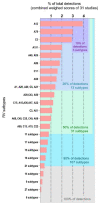Understanding Rhinovirus Circulation and Impact on Illness
- PMID: 35062345
- PMCID: PMC8778310
- DOI: 10.3390/v14010141
Understanding Rhinovirus Circulation and Impact on Illness
Abstract
Rhinoviruses (RVs) have been reported as one of the main viral causes for severe respiratory illnesses that may require hospitalization, competing with the burden of other respiratory viruses such as influenza and RSV in terms of severity, economic cost, and resource utilization. With three species and 169 subtypes, RV presents the greatest diversity within the Enterovirus genus, and despite the efforts of the research community to identify clinically relevant subtypes to target therapeutic strategies, the role of species and subtype in the clinical outcomes of RV infection remains unclear. This review aims to collect and organize data relevant to RV illness in order to find patterns and links with species and/or subtype, with a specific focus on species and subtype diversity in clinical studies typing of respiratory samples.
Keywords: asthma; childhood; circulation; genotyping; respiratory; rhinovirus; serotyping; typing; virulence.
Conflict of interest statement
The authors declare no conflict of interest.
Figures

References
Publication types
MeSH terms
LinkOut - more resources
Full Text Sources
Other Literature Sources

